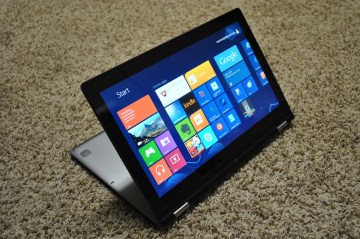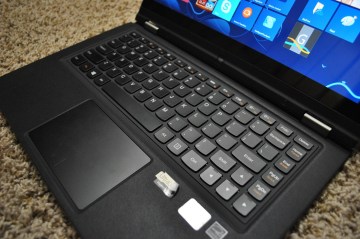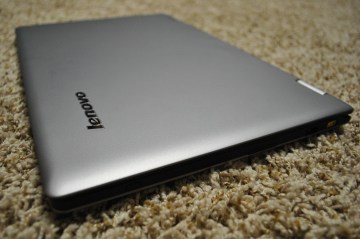For laptop makers, now is a time of experimentation. After years in pursuit of the same old goals — thinner, lighter, faster, cheaper — Windows 8 has provided a novel challenge: Create laptops that can transform into tablets, or vice versa.
Lenovo’s IdeaPad Yoga 13, which starts at $1,000, is just one attempt to take advantage of Microsoft’s dual-sided operating system. Out of the box, it looks like a traditional notebook, but keep tilting the 13-inch touchscreen back along its hinge, and it folds all the way around until the clamshell is closed again. Only now, the screen is face-up, and the keyboard hangs from the underbelly. You can also open the Yoga partway, keys down, so the screen is facing outward, or stand the device on both of its edges in a tent-like configuration.
This approach is simple and logical enough, but after spending a week with a Lenovo Yoga review unit, I think it’s a better laptop than it is a tablet.
The Yoga is clad in plastic, but it’s a soft-touch material that doesn’t feel like the cheap shells of budget laptops, and the area where you rest your palms almost has a leathery feel. Among Windows laptops, it’s the rare high-end design that doesn’t feel ripped off from Apple‘s MacBooks, yet its keyboard and trackpad are just as good.
The trackpad is generously sized and covered in glass, so your fingers glide over it smoothly, and the entire surface clicks with ease. It also supports multi-touch gestures, such as two-finger scrolling, pinch-to-zoom and the ability to simulate right-clicks by depressing the pane with both fingers. The Yoga’s keyboard is also a pleasure to type on, with island-style keys that let out a satisfying clack. One particularly nice touch is the rounded edge on the bottom of each key, which seems to leave just a bit more room for your fingers to land.
The display isn’t too chintzy, either, though it does beg for the occasional swipe of a cloth as fingerprints build up. Although some users may pine for a higher resolution than 1600-by-900, this pixel density strikes a happy compromise, where text is fairly crisp but the desktop elements remain large enough to tap on, should the modern interface of Windows 8 fail to suit your needs.
As for performance, the Yoga’s Intel Core i5 processor provides more than enough power for ordinary tasks such as word processing, web browsing and streaming video. It can even handle some newer PC games; I loaded Guild Wars 2 on it, and had no trouble adventuring through its massive world.
The Yoga does falter slightly on battery life, which in my experience floated in the five- to six-hour range. That’s not terrible for a laptop, but it’s far below average for a tablet. Unfortunately, any tablet based on Intel’s Core processors will have this problem, and the only alternative is to sacrifice processing power.
The bigger issue with the Yoga is its storage situation, as pointed out by the Wall Street Journal‘s Walt Mossberg and ZDNet’s Ed Bott. The Yoga uses solid state storage instead of a hard disc drive, so instead of having lots of space, you get much zippier performance. That’s a fine tradeoff in the age of cloud storage and cheap external hard drives, but the problem is that despite an advertised 128 GB of storage, only about half of it is available to users, and it’s divided across two partitions. The rest is gobbled up by recovery services, built-in software, the operating system itself and other mysterious partitions whose purpose is unknown. Users can reclaim some of this storage through an elaborate workaround, but that only underscores how bad the situation is out of the box.
Those gripes aside, Lenovo’s Yoga is still an excellent high-end Windows laptop. But its laptopness (for lack of a better term) is exactly what prevents it from being an excellent tablet.
My feeling is that if PC makers are going to put touchscreens on their laptops, they ought to at least provide some way for the keyboard and trackpad to get out of the way. The Yoga accomplishes this goal, but crudely. Hold it in your hands as a tablet, and you’ll feel the keys under your fingers.
In practice, this isn’t as bad as it sounds; the keys are disabled in tablet mode, and they’re barely noticeable when the device is resting on your lap. Still, the combination of awkward key placement, a weight of 3.3 pounds, a thickness of 0.7 inches and the jumbo 13-inch display can all feel like too much, especially if you’re playing a touchscreen game or propping the tablet on your chest for bedtime reading. You’ll hear the whir of the system’s fan the whole time as well.

I must admit that on a few occasions, the Yoga achieved hybrid greatness. The hinged design is so easy to flip around that I’ve gotten into the habit of switching to tablet mode just to read a long article — usually in portrait mode, like some futuristic broadsheet newspaper — or to scroll through Twitter. If I had this device for longer, I could imagine using its outward-facing screen to check recipes while cooking, or to play games while reclined with a controller in-hand. There’s something to this design, despite its flaws. Even so, the lack of Windows 8 apps so far holds the Yoga back from what it could become.
The question, then, is whether Lenovo’s IdeaPad Yoga is worth the price premium over other high-end Ultrabook laptops. The answer is only “yes” if you need to buy a laptop now, if your basic tablet needs are already covered by another device — say, the iPad or a smaller tablet like the Nexus 7 — and if you’re willing to gamble on Windows 8’s app situation getting better. Worst-case scenario, you’ll still end up with a great laptop.
But as someone who’s personally in the market for a new laptop, I’m planning to see what comes in the next few months, including Microsoft‘s Surface with Windows 8 Pro and other announced but unreleased hybrids. I’ve enjoyed using Lenovo’s Yoga, but this being a time of experimentation and all, I’m also anxious to see more results.



